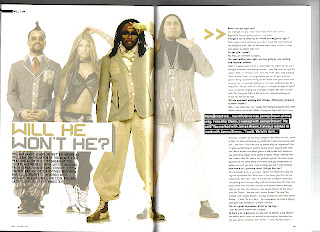When I began my preliminary task I had relatively little experience using digital image editing software. Due to this, the cover that I produced contained main armature errors. The first of these errors was that I over edited the model. This caused the whole image to lose its sense of realism. Not only did it lack realism but it made the featured person look inhuman, therefore making it completely unsuitable for a school magazine. Another fatal flaw of mine was to include far too little text. The lack of text completely defies the conventions of magazines and gives a feeling that it is an unprofessional piece of work. In addition to this, my main feature ('New Uniform!') has absolutely no relevance whatsoever to the magazines image. The text implies that there is a new school uniform but the featured student is wearing an anorak, this will without a doubt cause massive confusion to any readers of the magazine. Finally, the covers sticker is far too large and provides very little to entice any potential customers ('win a £10 book voucher').
(my preliminary task front cover)
Due to the failings of my preliminary front cover I decided to teach myself how to use editing software properly and what various music magazines did to look so professional. Learning the basics of the software I was going to be using (Cinema 4D, Adobe Photoshop and CorelDraw Graphics Suite) was a long a difficult process. However I believe that overall it was definitely worth it, to teach myself how, I watched many video tutorials on Youtube (an extremely popular video sharing website) and read a verity of guides on the internet. I believe that my final front cover is vastly more professional that my preliminary task one and that it follows a greater amount of conventions. One of the key improvements was the larger verity of fonts. In my preliminary task I only used two different fonts (one for the masthead and another for everything else) where I used a total of four in my final cover (double the amount used in my preliminary task). My editing had greatly improved as well. In the final cover I was able to utilize three dimensional items, special effects, overlays and cutting to make my product unique and looking nice. I also learnt about a range of magazine front cover devices such as mastheads, plugs, straplines, coverlines, puffs and barcodes, many of which I used in my final product.
(my final front cover)
My preliminary contents page was of a extremely poor level of design. It lacked in almost every aspect and was far too basic for its intended purpose. The only aspect which I consider myself to have done well in was to number the pages and keep the font similar to that of the preliminary front cover. I believe that I have learnt a great deal about magazine construction since I made this. Improvements which I have included in my final design include section titles, a greater amount of listed pages, a higher quality design of title, more pictures and various quotes.
(my preliminary contents page)
(my final contents page)
Overall, I think that I have dramatically improved in magazine creation. I believe that my final products are of a high quality and would not look out of place on a stores shelf. This was acknowledged in the positive feedback which I received.


























































